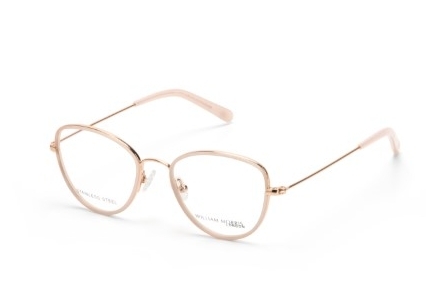Framing your high-prescription patients
Your high-prescription patients need a little extra TLC. After all, some may have had a long (and scarring!) history of choosing frames to hide those scarily thick lenses without much success. But gone are the days of that dreaded ‘coke bottle’ effect, as there are plenty of ways to guide these patients towards a frame that is both functional and fashionable.
Educate first
In choosing a suitable frame for high-prescription patients, educating them is paramount. But your first port of call is thoroughly understanding the prescription yourself, says Courtney Chellew, vice president of the Association of Dispensing Opticians of New Zealand (ADONZ).
“Has the prescribing optometrist noted the back vertex distance (BVD) on the prescription? Is it high myopia or hypermetropia? What does the optical cross look like? Where would the thickest parts of the lens fall due to the principal powers? You should then allow this base knowledge to guide frame selection.”

Courtney Chellew
Once you’ve got to grips with the prescription, says April Petrusma, CEO of Optical Dispensers Australia, setting expectations via patient education can be the determining factor for a successful outcome. “By providing simple advice, like the significance of the correct wearing position (such as not wearing the spectacles down the nose), you’re setting your patient up for success. If you’ve provided adequate information before the try-on at collection, your patient is more likely to respond with ‘I see what you mean’, rather than ‘something is wrong’. If you reach that phase, it’s very difficult to back-pedal, which can also be seen as unprofessional.”

April Petrusma
Petrusma advises relying on your dispensing expertise, rather than allowing the patient to choose purely on taste. While that is important, she says, you’re in the driver’s seat when it comes to determining if the frame is suitable for the required lenses. On this topic, Chellew recommends taking every measurement you can, with the bare minimum considerations for frames being the BVD, followed by pantoscopic tilt and size of the lens.
“Take a quick look while the patient is checking the frames in the mirror. If the BVD looks like it differs significantly from the prescription, then adjustments will need to be made to account for spectacle magnification – an online BVD calculator can be useful. Try to keep the BVD closer to the face. You can increase field of view with one simple consideration – does the frame have enough of an angle on it? If it’s too flat planed, think about what effect this will have once your client looks away from the optical centre. If the frame is too big and requires more decentration, then thickness and weight start to be an issue. There is of course the use of higher indices to counter this, but proper frame selection should always be a priority here!”
Chellew recommends explaining what you are doing and why, as this increases the perceived value of the purchase and builds up client confidence in both you and the product choice.
“Be open and honest and clearly explain why you’ve chosen those particular frame options. Talk about the basics of the lenses in a way that resonates with the patient. Calculate thicknesses if they’re a technical type, talk about aesthetics or weight if that’s important to them. If you can demonstrate you have their best interests at heart and show you’re knowledgeable, they will trust and listen to your advice. Well, most of them will!”
Kristine Hammond, dispensing optician at the University of Auckland, agrees it’s important to explain your choices in a way the patient understands, without blinding them with science. “Make sure your patient is very involved in their frame choice. Offer to take photographs of them in different frames, as often their vision is limited without their glasses. It’s hard to get a sense of their appearance when they’re so close to the mirror. If they’re a contact lens wearer, suggest they wear them for their frame selection.”

Kristine Hammond
According to Jo Holmes, president of the Association of British Dispensing Opticians, frame collection is another great opportunity for further patient education. “You can reinforce the need for correctly fitting frames. Encourage them to come back for adjustments when the frame becomes loose, as this will aid the best vision looking through the correct part of the lens.”

Jo Holmes
Small but perfectly formed
Petrusma says that when it comes to frame shape for high-prescription patients, size does matter. “Large frames, which unavoidably result in large lens diameters, will increase the lens thickness and encourage potential problems. Unsymmetrical shapes such as aviators result in long corridors and unnecessary vertical thickness. Other than the more obvious issues of weight and unattractive appearance that come with thick lenses, there are additional optical considerations such as chromatic aberrations, spectacle magnification issues and ring scotoma. As a rule of thumb, the smaller and more evenly shaped the frame and lens, the less chance there is of provoking ongoing issues.”
Holmes recommends regular shapes, such as round, oval or square with rounded corners and says it’s best to avoid elongated or extreme shapes. Hammond says that to hide edge thickness in a high myope, or to get the thinnest lens possible in a high hyperope, a full-rimmed frame is the best option.
Get materialistic
The choice of materials for both the frame and lenses can make the difference between success and a disappointed patient, adds Petrusma. “Ask yourself if the lens material will give you the best optical outcome and if the frame material is suitable for the lens choice. For example, if you have a high-minus powered lens that’s inevitably going to have edge thickness regardless of the index you choose, you should select a shell frame to hide the thickness and allow for lens stability.”
Holmes suggests acetate frames, while Hammond recommends plastic for hiding edge thickness. However, it’s still important to be mindful of the nose bridge fit, says Hammond. “A poor-fitting plastic frame that doesn’t sit on the nose correctly will continually slip down and impact the function of the prescription lenses. There are plastic frames that have nose pad arms and pads attached, which are very helpful for patients with a narrow nose bridge.”

Superdry SDO Alby 172
Holmes advises against semi-rimless (supra) frames but feels that sometimes a metal frame is suitable as it is easier to alter the BVD via the pads.

Etnia Barcelona Richmond

William Morris 55001
When it comes to lens material choice, Chellew likes aspherics for reduced thickness, weight and improving image quality. “If you’re using aspheric lenses, remember the importance of pantoscopic tilt and adjust your heights! Think about frame shape and how that’s going to help reduce your thickness. If you have a scarily high prescription, you can talk to the team at Independent Lens Specialists about blended lenticulars; they’re pretty cool. I’m also not afraid to ask clients to take a seat while I run calculations of what their lenses will look like in order to find the best solutions.”
Petrusma says the Abbe number is important when dispensing high-powered lenses. “With Abbe number and lens power being the two main contributing factors to chromatic aberrations, patients wearing high-powered lenses in polycarbonate (Abbe value of 30) would likely notice colour fringing. Since polycarbonate has significant high impact resistance properties, it doesn’t mean it should be avoided for patients requiring high-powered lenses, but they require an informed decision. You could also consider Trivex, which has a higher Abbe value of 45.”
Petrusma says glass lenses, while heavy, are an appealing choice for high-powered lenses. They offer the highest refractive index available in any material and are extremely thin. But as glass has low impact resistance and easily shatters, careful thought should be given to the patient’s lifestyle and safety requirements.


Renee Lunder is an Australian freelance journalist and proud specs wearer.
























